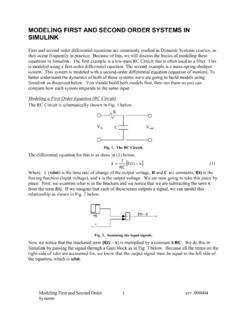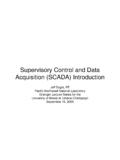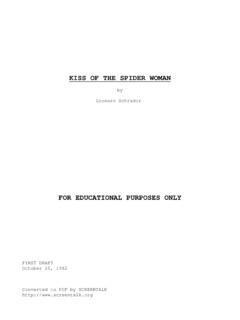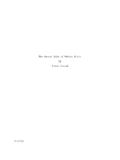Transcription of OVERVIEW MICROPROCESSORS - Clark Science …
1 GENERALA microprocessor is one of the most exciting technological innovations in electronics since theappearance of the transistor in 1948. This wonder device has not only set in the process ofrevolutionizing the field of digital electronics, but it is also getting entry into almost everysphere of human life. Applications of MICROPROCESSORS range from the very sophisticated processcontrollers and supervisory control equipment to simple game machines and even is, therefore, imperative for every engineer, specially electronics engineer, to knowabout MICROPROCESSORS . Every designer of electronic products needs to learn how to usemicroprocessors. Even if he has no immediate plans to use a microprocessor , he should haveknowledge of the subject so that he can intelligently plan his future projects and can makesound engineering judgements when the time subject of MICROPROCESSORS is overviewed here with the objective that a beginner getsto know what a microprocessor is, what it can do, how it fits in a system and gets an overallidea of the various components of such a system.
2 Once he has understood signam of eachcomponent and its place in the system, he can go deeper into the working details and design ofindividual components without WHAT IS A MICROCOMPUTER?To an engineer who is familiar with mainframe and mini computers, a microcomputer is simplya less powerful mini computer. Microcomputers have smaller instruction sets and are slowerthan mini computers, but then they are far less expensive and smaller an engineer with a hardware background and no computer experience, a microcomputerwill look like a sequential state machine that can functionally replace thousands of randomlogic chips, but occupies a much lesser space, costs much lesser and the number of deviceinterconnections being fewer in it, is much more microcomputer is primarily suited, because of its very low cost and very small size, todedicated applications.
3 On the same grounds, the mainframe computer is as a rule suitable asa general purpose computer. Mini computer finds applications in both WHAT IS A microprocessor ?A computer, large or small, can be represented functionally (in a simplified form) by the blockdiagram in Figure. As shown, it comprises of three basic parts or sub-systems: OVERVIEW OF MICROPROCESSORSCHAPTER 12 Advanced MicroprocessorsFigure Block Digram of Microcomputer(a) Central Processing Unit (CPU)It performs the necessary arithmetic and logic operations and controls the timing and generaloperation of the complete system.(b) Input/Output (I/O) DevicesInput devices are used for feeding data into the CPU, examples of these devices are toggleswitches, analog-to-digital converters, paper tape readers, card readers, keyboards, disk output devices are used for delivering the results of computations to the outside world;examples are light emitting diodes, cathode ray tube (CRT) displays, digital-to-analog converters,card and paper-tape punches, character printers, plotters, communication lines etc.
4 The input-output subsystem thus allows the computer to usefully communicate with the outside devices are also called as peripherals.(c) MemoryIt stores both the instructions to be executed ( , the program) and the data involved. Itusually consists of both RAMs (random-access memories) and ROMS (read-only memories).A microprocessor is an integrated circuit designed to function as the CPU of WHAT IS INSIDE A microprocessor ?The microprocessor or CPU reads each instruction from the memory, decodes it and executesit. It processes the data as required in the instructions. The processing is in the form of arithmeticand logical operations. The data is retrieved from memory or taken from an input device andthe result of processing is stored in the memory or delivered to an appropriate output device,all as per the perform all these functions, the P ( microprocessor ) incorporates various functionalunits in an appropriate manner.
5 Such an internal structure or organizational structure of P,which determines how it operates, is known as its / OOverview of Microprocessors3A typical microprocessor architecture is shown in Figure The various functional unitsare as follows:Figure Architecture of Busses C (microcomputer), like all computers, manipulates binary information. The binary informationis represented by binary digits, called bits. C operates on a group of bits which are referred toas a word. The number of bits making- P a word varies with the P. Common word sizes are 4,8, 12 and 16 bits ( Ps with 32 bit-word have also of late entered the market). Another binaryterms that will be of interest in subsequent discussions are the byte and the nibble, whichrepresent a set of 8 bits and 4 bits, shows busses interconnecting various blocks.
6 These busses allow exchange ofwords between the blocks. A bus has a wire or line for each bit and thus allows exchange of all bitsof a word in parallel. The processing of bits in the P is also in parallel. The busses can thus beviewed as data highways. The width of a bus is the number of signal lines that constitute the figure shows for simplicity three busses for distinct functions. Over the address bus,the P transmits the address of that I/O device or memory locations which it desires to address is received by all the devices connected to the processor, but only the device whichhas been addressed responds. The data bus is used by the P to send and receive data to andfrom different devices (I/O and memory) including instructions stored in memory.
7 Obviouslythe address bus is unidirectional and the data bus is bi-directional. The control bus is used fortransmitting and receiving control signals between the P and various devices in the Arithmetic-Logic Unit (ALU)The arithmetic-logic unit is a combinational network that performs arithmetic and logicaloperations on the Internal RegistersA number of registers are normally included in the microprocessor . These are used for temporarystorage of data, instructions and addresses during execution of a program. Those in the Intel PALUREGISTERARRAYINPUTROMRAMMEMORYCONTRO LINTERNAL BUS )(ADDRESS, DATAOUTPUT4 Advanced Microprocessors8085 microprocessor are typical and are described below:(i) Accumulator (Acc) or Result RegisterThis is an 8-bit register used in various arithmetic and logical operations.
8 Out of the twooperands to be operated upon, one comes from accumulator (Acc), whilst the other one may bein another internal register or may be brought in by the data bus from the main memory. Uponcompletion of the arithmetic/logical operation, the result is placed in the accumulator (replacingthe earlier operand). Because of the later function, this register is also called as result register.(ii) General Purpose Registers or Scratch Pad MemoryThere are six general purpose 8-bit registers that can be used by the programmer for a varietyof purposes. These registers, labelled as B, C, D, E, H and L, can be used individually ( ,when operation on 8-bit data is desired) or in pairs ( , when a 16-bit address is to be stored).
9 Only B-C, D-E and H-L pairs are allowed.(iii) Instruction Register (IR)This 8-bit register stores the next instruction to be executed. At the proper time this storedword (instruction) is fed to an instruction decoder which decodes it and supplied appropriatesignals to the control unit. When the execution has been accomplished the new word in theinstruction register is processed.(iv) Program Counter (PC)This is a 16-bit register which holds the address of the next instruction that has to be fetchedfrom the main memory and loaded into the instruction register. The program controlling theoperation is stored in the main memory and instructions are retrieved from this memorynormally in order. Therefore, normally the address contained in the PC is incremented aftereach instruction is fetched.
10 However, certain classes of instruction can modify the PC so thatthe programmer can provide for branching away from the normal program flow. Examples areinstructions in the jump and call subroutine groups.(v) Stack Pointer (SP)This is also a 16-bit register and is used by the programmer to maintain a stack in the memorywhile using subroutines.(vi) Status Register or Condition FlagsA status register consisting of a few flip-flops, called as condition flags (in 8085 the number offlags is five) is used to provide indication of certain conditions that arise during arithmetic andlogical operations. These are: zero Flag is set if result of instruction is 0. sign Set if MSB of result is 1. parity Set if result has even parity.










